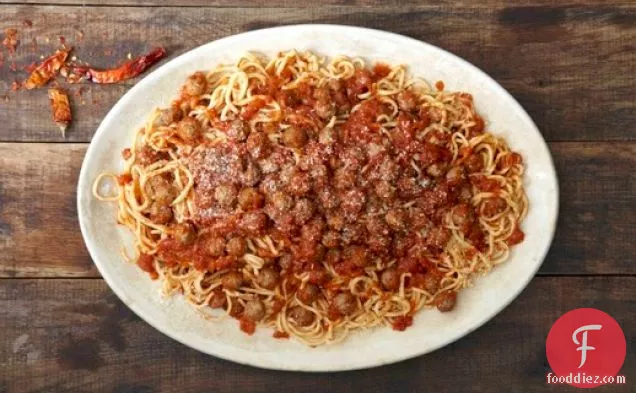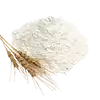Cook the Book: Maccheroni alla Chitarra with Ragù Abruzzese and Palottine

Cook the Book: Maccheroni alla Chitarra with Ragù Abruzzese and Palottine might be just the main course you are searching for. This recipe covers 29% of your daily requirements of vitamins and minerals. This recipe makes 8 servings with 482 calories, 38g of protein, and 21g of fat each. From preparation to the plate, this recipe takes around 4 hours. Head to the store and pick up semolina flour, tomatoes, ground veal, and a few other things to make it today. To use up the eggs you could follow this main course with the Rose Levy Beranbaum's Chocolate Tomato Cake with Mystery Ganache as a dessert.
Instructions
1
For the Ragù all’Abruzzese: Warm the vegetable oil in a large Dutch oven or other heavy-bottomed pot placed over medium heat. Season the pieces of meat with a little salt and pepper and add them to the pot. Brown for 3 to 4 minutes, then turn the pieces to brown the other side, another 3 to 4 minutes. Continue to brown the meat until it is nicely seared all over.
Ingredients you will need![Salt And Pepper]() Salt And Pepper
Salt And Pepper![Vegetable Oil]() Vegetable Oil
Vegetable Oil![Meat]() Meat
Meat
Equipment you will use![Dutch Oven]() Dutch Oven
Dutch Oven
3
Pass the tomatoes through a food mill fitted with the disk with the smallest holes. Discard the solids. Set the milled tomatoes aside.
Ingredients you will need![Tomato]() Tomato
Tomato
4
Return the pot to medium heat and add the extra-virgin olive oil. Stir in the onion, reduce the heat to medium-low, and sauté for about 5 minutes, or until the onion is shiny and beginning to soften.
Ingredients you will need![Extra Virgin Olive Oil]() Extra Virgin Olive Oil
Extra Virgin Olive Oil![Onion]() Onion
Onion
Equipment you will use![Pot]() Pot
Pot
5
Pour in the tomatoes, raise the heat to medium-high, and bring to a simmer. Return the meat to the pot and reduce the heat to medium-low or low to maintain a gentle simmer. Cover partially and let the sauce simmer, stirring it from time to time, for about 3 hours, or until the meat is very tender and the sauce is thickened.
Ingredients you will need![Tomato]() Tomato
Tomato![Sauce]() Sauce
Sauce![Meat]() Meat
Meat
Equipment you will use![Pot]() Pot
Pot
6
Add a splash or two of water if the sauce thickens too much before the meat is done. Taste and adjust the seasoning with salt and pepper, if you like.
Ingredients you will need![Salt And Pepper]() Salt And Pepper
Salt And Pepper![Seasoning]() Seasoning
Seasoning![Sauce]() Sauce
Sauce![Water]() Water
Water![Meat]() Meat
Meat
8
Remove the meat from the pot before using the sauce.
Ingredients you will need![Sauce]() Sauce
Sauce![Meat]() Meat
Meat
Equipment you will use![Pot]() Pot
Pot
9
For the Fresh Egg Pasta Dough: To mix the dough in the food processor: Put 2 cups “00” flour, the 1 tbsp semolina flour, salt, and nutmeg into the work bowl and pulse briefly to combine. Break the eggs into the work bowl and drizzle in 1 tbsp of the olive oil. Process the mixture until it forms crumbs that look like small curds. Pinch together a bit of the mixture and roll it around. It should form a soft ball. If the mixture seems dry, drizzle in the remaining 1 tbsp oil and pulse briefly. If it seems too wet and sticky, add additional flour, 1 tbsp at a time, and pulse briefly.
Ingredients you will need![Semolina Flour]() Semolina Flour
Semolina Flour![Pasta Dough]() Pasta Dough
Pasta Dough![Olive Oil]() Olive Oil
Olive Oil![Nutmeg]() Nutmeg
Nutmeg![Dough]() Dough
Dough![All Purpose Flour]() All Purpose Flour
All Purpose Flour![Egg]() Egg
Egg![Roll]() Roll
Roll![Salt]() Salt
Salt![Cooking Oil]() Cooking Oil
Cooking Oil
Equipment you will use![Food Processor]() Food Processor
Food Processor![Bowl]() Bowl
Bowl
10
Turn the mixture out onto a clean work surface sprinkled lightly with semolina flour and press it together with your hands to form a rough ball. Knead the dough: Using the palm of your hand, push the dough gently but firmly away from you, and then fold it over toward you. Rotate the dough a quarter turn, and repeat the pushing and folding motion. Continue kneading for several minutes until the dough is smooth and silky. Form it into a ball and wrap it tightly in plastic wrap.
Ingredients you will need![Semolina Flour]() Semolina Flour
Semolina Flour![Dough]() Dough
Dough![Wrap]() Wrap
Wrap
Equipment you will use![Plastic Wrap]() Plastic Wrap
Plastic Wrap
1
Combine 2 1/4 cups “00” flour, the 1 tbsp semolina flour, salt, and nutmeg on a clean work surface and pile into a mound. Make a well in the center of the mound, and break the eggs into it.
Ingredients you will need![Semolina Flour]() Semolina Flour
Semolina Flour![Nutmeg]() Nutmeg
Nutmeg![All Purpose Flour]() All Purpose Flour
All Purpose Flour![Egg]() Egg
Egg![Salt]() Salt
Salt
2
Drizzle 1 tbsp of the olive oil into the well. With a fork, break the egg yolks and whisk together the eggs and oil. Using the fork, gradually draw the flour from the inside wall of the well into the egg mixture until it has a batterlike consistency. Work carefully so that you don’t break the wall of flour, causing the egg mixture to run out and things to get messy. (If this happens, don’t panic; just use your palms to scoop up the egg mixture and work it back into the flour.)
Ingredients you will need![Egg Yolk]() Egg Yolk
Egg Yolk![Olive Oil]() Olive Oil
Olive Oil![All Purpose Flour]() All Purpose Flour
All Purpose Flour![Egg]() Egg
Egg![Cooking Oil]() Cooking Oil
Cooking Oil
Equipment you will use![Whisk]() Whisk
Whisk
3
Now, use your hands to draw the remaining wall of flour over the thickened egg mixture and begin to mix it and knead it. Using the palm of your hand, push the dough gently but firmly away from you, and then fold it over toward you. Rotate the dough a quarter turn, and repeat the pushing and folding motion. Use a dough scraper to dislodge any bits stuck to the work surface. The dough will begin as a shaggy mass but will eventually turn smooth as you knead it over several minutes. You may not use all of the flour on the work surface. When the dough is smooth and silky, form it into a ball and wrap it tightly in plastic wrap.
Ingredients you will need![Dough]() Dough
Dough![All Purpose Flour]() All Purpose Flour
All Purpose Flour![Wrap]() Wrap
Wrap![Egg]() Egg
Egg
Equipment you will use![Dough Scraper]() Dough Scraper
Dough Scraper![Plastic Wrap]() Plastic Wrap
Plastic Wrap
5
Stretching the dough: Set up your pasta machine with the rollers on the widest setting (#1 on my standard Marcato Atlas machine). Scatter a little semolina flour on the work surface around the machine and have more on hand for sprinkling on the dough.
Ingredients you will need![Semolina Flour]() Semolina Flour
Semolina Flour![Dough]() Dough
Dough![Pasta]() Pasta
Pasta
Equipment you will use![Pasta Machine]() Pasta Machine
Pasta Machine
6
Cut the dough into four equal pieces, and rewrap three pieces. Knead the remaining piece briefly on the work surface. Then, using a rolling pin or patting it with the heel of your hand, form the dough into an oval 3 to 4 in long and about 3 in wide. Feed the dough through the rollers of the pasta machine, and then lay the strip on the work surface. Fold the dough into thirds, like folding a business letter, sprinkle with a little semolina, and pass it through the rollers again.
Ingredients you will need![Semolina]() Semolina
Semolina![Dough]() Dough
Dough![Pasta]() Pasta
Pasta
Equipment you will use![Pasta Machine]() Pasta Machine
Pasta Machine![Rolling Pin]() Rolling Pin
Rolling Pin
7
Repeat the folding and rolling process a few more times, until the strip of dough is smooth. Move the roller setting to the next narrower notch and feed the strip of dough through the setting twice, sprinkling it with a little semolina each time to keep it from sticking and then moving the notch to the next setting. Continue to pass the dough through the rollers twice on each setting, until you have stretched it to the appropriate thickness. This will depend on which cut you are making, so be sure to read carefully the individual recipes and instructions for cutting the various shapes. Most recipes, including those for ravioli and lasagne, call for stretching the dough very thin—about 1/16 in—though some cuts require a thicker sheet. On my machine, passing the dough through the second-narrowest roller setting (#
Ingredients you will need![Semolina]() Semolina
Semolina![Ravioli]() Ravioli
Ravioli![Dough]() Dough
Dough
8
produces a very thin pasta sheet, so I usually don’t stretch past that setting.
Ingredients you will need![Pasta]() Pasta
Pasta
9
Once you have stretched your piece of dough (it will be a fairly long ribbon, depending on how thin you have stretched it), lay it out on a semolina-dusted surface and cover it lightly with plastic wrap while you stretch the remaining 3 pieces.
Ingredients you will need![Semolina]() Semolina
Semolina![Dough]() Dough
Dough![Wrap]() Wrap
Wrap
Equipment you will use![Plastic Wrap]() Plastic Wrap
Plastic Wrap
1
Put the veal, salt, nutmeg, and egg in a bowl and mix together thoroughly (I use my hands). With your fingers, pinch off a very small piece of the mixture and roll it into a tiny ball—not much larger than a chickpea.
Ingredients you will need![Chickpeas]() Chickpeas
Chickpeas![Nutmeg]() Nutmeg
Nutmeg![Roll]() Roll
Roll![Salt]() Salt
Salt![Veal]() Veal
Veal![Egg]() Egg
Egg
Equipment you will use![Bowl]() Bowl
Bowl
2
Place the meatball on a clean tray or platter. Repeat until you have rolled all of the veal mixture into meatballs.
Ingredients you will need![Meatballs]() Meatballs
Meatballs![Veal]() Veal
Veal
3
Pour the vegetable oil to a depth of 1/4 in in a frying pan, place over medium-high heat, and heat to 375°F on a deep-frying thermometer. If you don’t have a thermometer, carefully drop a meatball into the hot oil; if it sizzles on contact, the oil is ready.
Ingredients you will need![Cooking Oil]() Cooking Oil
Cooking Oil![Meatballs]() Meatballs
Meatballs
Equipment you will use![Kitchen Thermometer]() Kitchen Thermometer
Kitchen Thermometer![Frying Pan]() Frying Pan
Frying Pan
4
Place a platter lined with a double layer of paper towels or a large, plain brown-paper bag near the stove.
Equipment you will use![Paper Towels]() Paper Towels
Paper Towels![Stove]() Stove
Stove
5
Carefully add the meatballs to the hot oil, working in batches to avoid crowding the pan. Fry them, turning them from time to time with a spatula, slotted spoon, or even a fork, for about 4 minutes, or until they are lightly browned. Use a slotted spoon or a skimmer to remove the meatballs to the prepared platter. Repeat until all the meatballs are fried.
Ingredients you will need![Meatballs]() Meatballs
Meatballs![Cooking Oil]() Cooking Oil
Cooking Oil
Equipment you will use![Slotted Spoon]() Slotted Spoon
Slotted Spoon![Skimmer]() Skimmer
Skimmer![Spatula]() Spatula
Spatula![Frying Pan]() Frying Pan
Frying Pan
6
Transfer the meatballs to the pot with the ragù. Return the sauce to a simmer over medium-low heat, then reduce the heat to low, cover, and keep the sauce at a very low simmer while you cook the pasta.
Ingredients you will need![Meatballs]() Meatballs
Meatballs![Pasta]() Pasta
Pasta![Sauce]() Sauce
Sauce
Equipment you will use![Pot]() Pot
Pot
7
Bring a very large pot or a stockpot of water to a rolling boil and salt generously. Carefully drop each maccheroni “nest” into the boiling water and stir to separate the strands. Cover the pot until the water returns to a boil, then uncover and cook for just a couple of minutes, or until very al dente. Taste a strand to make sure it is slightly undercooked.
Ingredients you will need![Water]() Water
Water![Salt]() Salt
Salt
Equipment you will use![Pot]() Pot
Pot
8
Drain the pasta in a colander set in the sink, reserving about 1 cup of the cooking water.
Ingredients you will need![Pasta]() Pasta
Pasta![Water]() Water
Water
Equipment you will use![Colander]() Colander
Colander
9
Return the drained pasta to the pot and spoon about two-thirds of the sauce over it. Gently toss the pasta and sauce to combine thoroughly, adding a splash or two of the cooking water if necessary to loosen the sauce.
Ingredients you will need![Pasta]() Pasta
Pasta![Sauce]() Sauce
Sauce![Water]() Water
Water
Equipment you will use![Pot]() Pot
Pot
Equipment
Ingredients
170grams![boneless beef chuck roast, cut into 4 equal pieces]() boneless beef chuck roast, cut into 4 equal pieces8servings
boneless beef chuck roast, cut into 4 equal pieces8servings![Freshly ground black pepper]() Freshly ground black pepper170grams
Freshly ground black pepper170grams![boneless pork shoulder, cut into 3 equal pieces]() boneless pork shoulder, cut into 3 equal pieces1large
boneless pork shoulder, cut into 3 equal pieces1large![egg, lightly beaten]() egg, lightly beaten3extra larges
egg, lightly beaten3extra larges![eggs]() eggs473milliliters
eggs473milliliters![00” flour or unbleached all-purpose]() 00” flour or unbleached all-purpose340grams
00” flour or unbleached all-purpose340grams![ground veal]() ground veal170grams
ground veal170grams![boneless lamb shoulder, cut into 3 equal pieces]() boneless lamb shoulder, cut into 3 equal pieces1pinch
boneless lamb shoulder, cut into 3 equal pieces1pinch![Pinch of freshly grated nutmeg]() Pinch of freshly grated nutmeg1Tbsp
Pinch of freshly grated nutmeg1Tbsp![extra-virgin olive oil]() extra-virgin olive oil8servings
extra-virgin olive oil8servings![Freshly grated Parmigiano-Reggiano cheese for serving]() Freshly grated Parmigiano-Reggiano cheese for serving8servings
Freshly grated Parmigiano-Reggiano cheese for serving8servings![Whole dried chiles or red pepper flakes for serving]() Whole dried chiles or red pepper flakes for serving1teaspoons
Whole dried chiles or red pepper flakes for serving1teaspoons![fine sea salt]() fine sea salt1Tbsp
fine sea salt1Tbsp![semolina flour, plus more for dusting the work surface and the dough]() semolina flour, plus more for dusting the work surface and the dough8servings
semolina flour, plus more for dusting the work surface and the dough8servings![Vegetable oil for frying]() Vegetable oil for frying1kilograms
Vegetable oil for frying1kilograms![whole or diced canned tomatoes, with their juice (about 7 1/2 cups)]() whole or diced canned tomatoes, with their juice (about 7 1/2 cups)1
whole or diced canned tomatoes, with their juice (about 7 1/2 cups)1![yellow onion, finely chopped]() yellow onion, finely chopped
yellow onion, finely chopped
 boneless beef chuck roast, cut into 4 equal pieces8servings
boneless beef chuck roast, cut into 4 equal pieces8servings Freshly ground black pepper170grams
Freshly ground black pepper170grams boneless pork shoulder, cut into 3 equal pieces1large
boneless pork shoulder, cut into 3 equal pieces1large egg, lightly beaten3extra larges
egg, lightly beaten3extra larges eggs473milliliters
eggs473milliliters 00” flour or unbleached all-purpose340grams
00” flour or unbleached all-purpose340grams ground veal170grams
ground veal170grams boneless lamb shoulder, cut into 3 equal pieces1pinch
boneless lamb shoulder, cut into 3 equal pieces1pinch Pinch of freshly grated nutmeg1Tbsp
Pinch of freshly grated nutmeg1Tbsp extra-virgin olive oil8servings
extra-virgin olive oil8servings Freshly grated Parmigiano-Reggiano cheese for serving8servings
Freshly grated Parmigiano-Reggiano cheese for serving8servings Whole dried chiles or red pepper flakes for serving1teaspoons
Whole dried chiles or red pepper flakes for serving1teaspoons fine sea salt1Tbsp
fine sea salt1Tbsp semolina flour, plus more for dusting the work surface and the dough8servings
semolina flour, plus more for dusting the work surface and the dough8servings Vegetable oil for frying1kilograms
Vegetable oil for frying1kilograms whole or diced canned tomatoes, with their juice (about 7 1/2 cups)1
whole or diced canned tomatoes, with their juice (about 7 1/2 cups)1 yellow onion, finely chopped
yellow onion, finely choppedDifficultyExpert
Ready In4 hrs
Servings8
Health Score41
Related recipes
Teriyaki Pork Kabobs
Veggie Chicken Rice Casserole
Brown Rice Slaw
Creamy, Cheesy Risotto
Magazine

Your Inner Chef with Taylor Swift's Top 3 Recipes from Her Beloved NYC Hangout

20 Mouthwatering Recipes You Need to Try Today!

Master the Art of Making Perfect Pancakes with This Foolproof Recipe

The Science Behind Red Wine: Its Surprising Health Benefits and Potential Risks

12 Wine Cocktails for a Sophisticated Twist

Sip, Swirl, and Celebrate: Toasting to National Wine Day on May 25th

National Drink Wine Day on February 18

Celebrating Souffle Day with Delectable Delights

Indulge in the Delightful Flavor of Oyster Soup on Its Special Day!

Celebrating World Nutella Day

12 Spring Vegetarian Recipes

15 Tasty Dessert Recipes

20 Best Breakfast Ideas to Enjoy this Spring

12 Healthy Spring Menu Ideas for 2022

Celebrate Spring with 3 Fresh Dishes

10 Healthy Springtime foods and How to Prepare Them

5 Simple Guidelines to Demystify 'Seasonal Cooking'

How to Grill Vegetables

How to Make Overnight Oats

How to Make Quiche

Your Inner Chef with Taylor Swift's Top 3 Recipes from Her Beloved NYC Hangout

20 Mouthwatering Recipes You Need to Try Today!

Sip, Swirl, and Celebrate: Toasting to National Wine Day on May 25th

National Drink Wine Day on February 18

Indulge in the Delightful Flavor of Oyster Soup on Its Special Day!

These Super Recipes for Your Football Party!

The Secrets Behind 3 Classic Comfort Food Recipes

Recipes to Spice Up Your February Menu

Top 20+ Must-Try Recipes Dominating February 2024

















